
How did you start your art practice?
I started when I was very young. I have always been drawing, writing small books of stories and creating costumes and theatre shows with my sister and cousins. My house was full of art, and my mother used to play piano and teach it to us. So I have always been on the performative side of things, of music and visual expression. Since then I see production in a transversal way, because of its intrinsic intertwined nature: drawing, painting, creating stage objects or costumes and small performances, and it's exactly the way I still work. It's basically a way of living. Nevertheless, having an art practice and being a professional artist are two different things, and I learnt about the second one when I came to Milano, where life was so fast and also so uncomfortable in a way. This gave me the opportunity to develop first of all as an individual, exploring my practice connected to my identity, and when you become able to stand up for yourself, it is easier to pursue your ideas and art. Before Milano I lived in Bologna where I studied anthropology and at the same time I was part of some theatre companies that worked with minor migrants, and we used to do transcultural performances. I always perceived art as a way to know other people, and to approach different realities through this common ground.
I see a lot of darkness in your personality. How would you describe your art? Where do you get inspired from?
I get mostly inspired by the things I see around me. Even though my works can seem obscure, I always look for the light. I grew up surrounded by animals and nature, and by the cruel tension between death and everyday life. It's funny but if you live in the city, death is something kind of hidden, while in the countryside you are much more connected to the natural processes. I get inspired by the horrors that we as humans live everyday and every night. Our nightmares, our anxieties, our body dysmorphia. The fear that somehow keeps us alive, but also already dead at the same time. I think the greatest poetry hides the scariest feelings and turns them into something beautiful. I would describe my art as the attempt to do this transformation. I get major inspiration by movies, especially by horror and sci-fi, starting from the Alien saga, going through David Cronenberg's Naked Lunch, ExistenZ, and all his movies exploring the horrors of the body, until Andrej Tarkovskij's landscape utopias and religious feeling; of course I am into Mad Max's post apocalypse aesthetic, even though the end of the world is once again described in the optics of a white straight male, but I enjoyed the costumes and the steampunk landscapes. As a young post-cyborg witch, I enjoyed Love Death Robots a lot, too. I love David Lynch and the classics of horror, and one of my favorite movies is Strange Circus by Sion Sono.
I feel like all my works are part of the scenography of a very big movie that keeps evolving, and every scene is a new chapter. Literature is also a big inspiration for me, both romance and 90s transfeminist posthuman wave. Rave culture and nightlife are also part of my life and my practice, as these subcultures explore in a very genuine and sincere way the contradictions of the world we are living in.
I feel like all my works are part of the scenography of a very big movie that keeps evolving, and every scene is a new chapter. Literature is also a big inspiration for me, both romance and 90s transfeminist posthuman wave. Rave culture and nightlife are also part of my life and my practice, as these subcultures explore in a very genuine and sincere way the contradictions of the world we are living in.
You were one of the youngest artists at the main pavilion of last year's Venice Biennale chosen by Cecilia Alemani. How have things developed for you since then?
I am so thankful to Cecilia Alemani and Marta Papini for giving me such trust. Since the Biennale, so many things have changed. I feel like I grew so much, as well as my art practice. I remember when I entered the pavilion to install my work, and I was speechless because of the magnitude of the space and of the other artworks. I became much more aware of the dynamics of this industry, and I am still building a more emotionally sustainable way of working. After that, I had a group show at Francesca Minini Gallery in Milan, which focused on metamorphic transformative bodies in a utopic post apocalyptic world, where I showed a new serie of works that somehow started a new wave in my production, because I introduced the use of wax and the human figure. I think the more you grow, the more you become aware of what you are doing: when you're young you produce a lot, but maybe you don't really know where it comes from, or where it is going. I am challenging myself more and more to go deep into my practice and explore its origins.
Many ask me how it is to be a female curator in Italy recently, I'd like to refer this question to you. Do you think there is any difference and sex of the artist has to do something with their career development? Do you have any personal stories?
I have so many stories I could write a book about it lol. And yes sex has always something to do with the personal and professional development of the individuals, because gender is first of all a theatre of different forces that move the way we live in the world. And maybe sex wouldn't be so crucial in itself, but it's about how others perceive us, and how their perception has an impact on how we perceive ourselves. As we all know, if you're a woman, or a female subjectivity, you will have to struggle twice as much as your male peers. First of all, you have to make it past high school, where objectification, rape culture, intrinsic misogyny and systemic violence shape the way you perceive your body and the relationship to others. After that, you face a world where males occupy all the positions of power: professors, curators, museum directors, or general males populating your world that will always try to mansplain you, try to diminish your ideas, or to f*ck you. Hence, yes, career wise I feel that being a woman totally makes a difference, because you are so used to face all these situations, that you become really good at defending your ideas, and the rage is big, as well as the will of revenge. I think it is difficult to do this job if you aren't at least a bit angry. We are living in a very interesting and challenging time, and I feel a wave of power coming from our bodies and our minds, even though the misogynistic and homophobic/transphobic waves eradicated in the Italian government and in Europe in general, that seem to have tightened up in the past years.
Could you talk about your upcoming show in London?
My works talk mainly about community in a broad sense. The bodies you see are moulds of my friends, lovers, people that constellate the galaxy I am living in. The natural or artificial parts that complete the sculptures are somehow the elements that interconnect the bodies to their environment, as in Furiosa the honeycombs grow from the cavities of the female body wearing a harness. For the show at Mamoth Gallery in London I am gonna bring a brand new piece: "Kobraltar". It's the seemingly suspended half naked body of a friend of mine wearing big raver platform shoes. Her wiry body arches in a position that both resonates with the Arch of Hysteria by Louise Bourgeois, and with a cyborg sci-fi narrative with her leg and shoes made of polished bronze. I see this work as a hallucination, an ecstatic vision someone could have after days of not sleeping, or in a desert because of the heat. It is the evolution of an insect, a metamorphic body in constant transformation. Here you can find the link to the GoFundMe for her transition and have more informations about her. I feel like my sculptures somehow depict both a self portrait, and the portrait of the person I decide to mould as how I imagine she would look like in another dimension. I am pretty much into the narrative of possibilities and dimensions, like the world of dreams, upside down realities or jumps in time. I perceive different realities as interconnected in a sort of upper wired consciousness that somehow regulates the world we are living in.
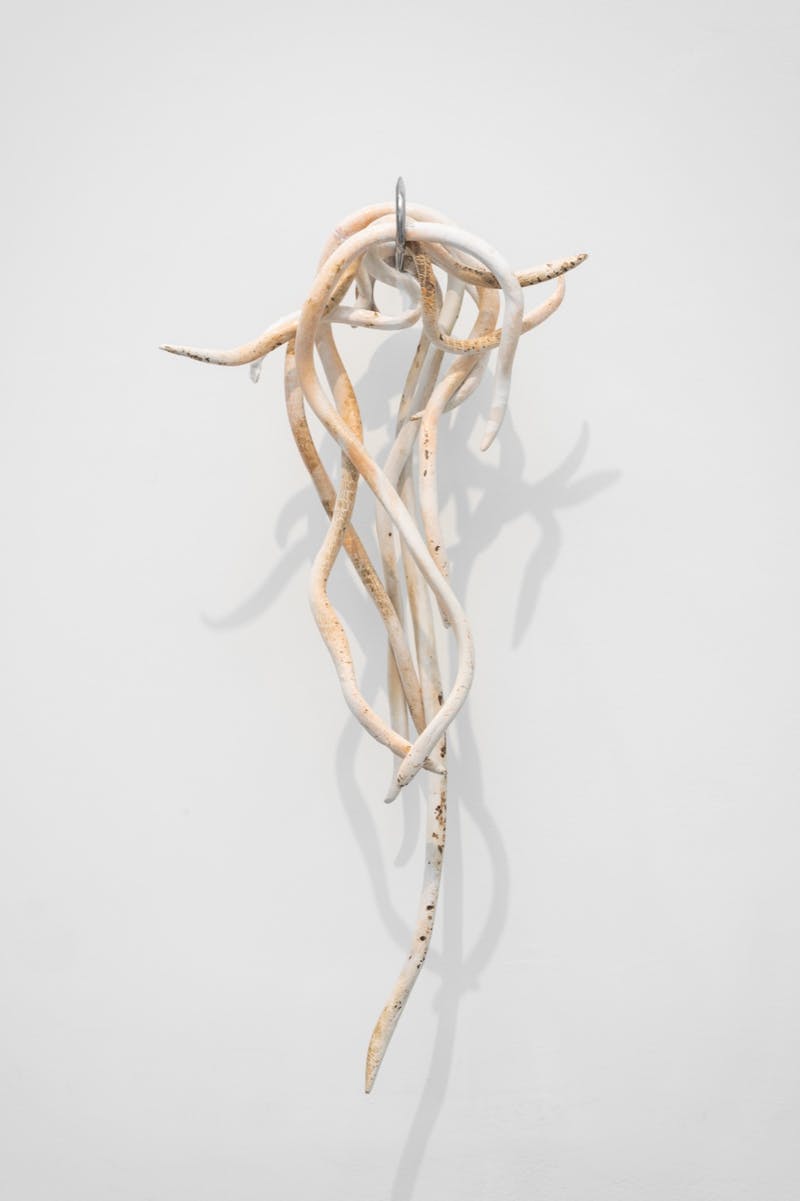
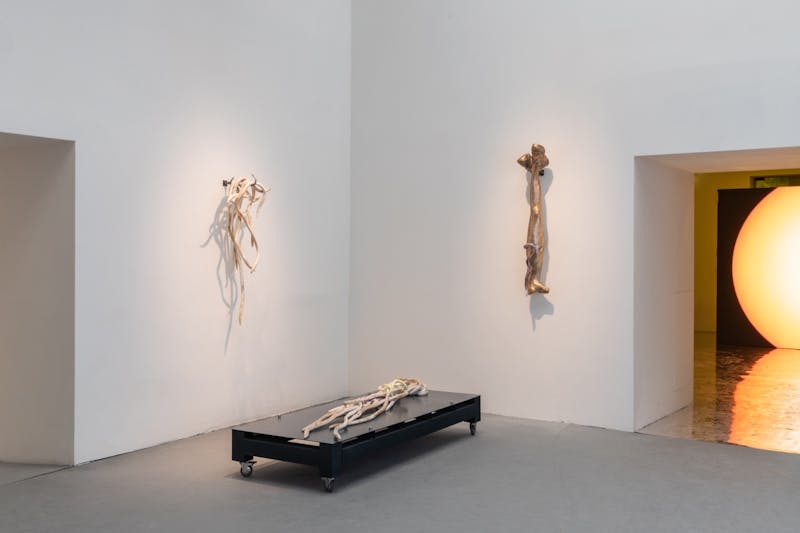
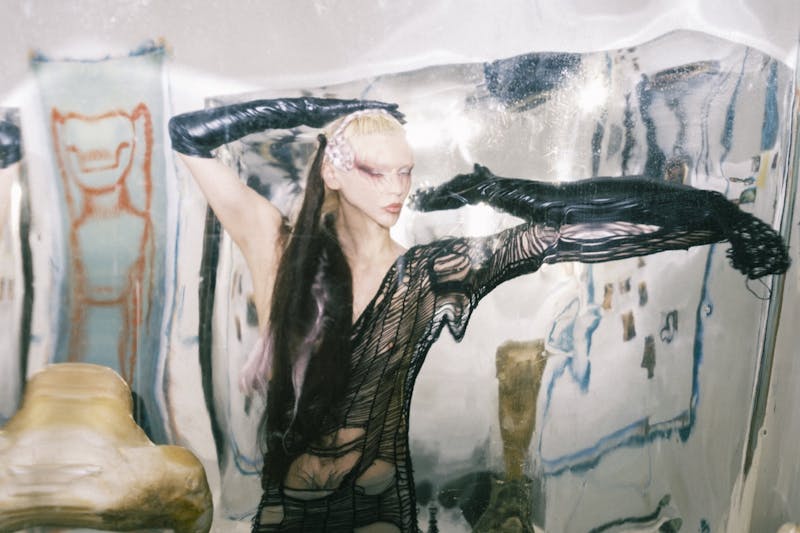
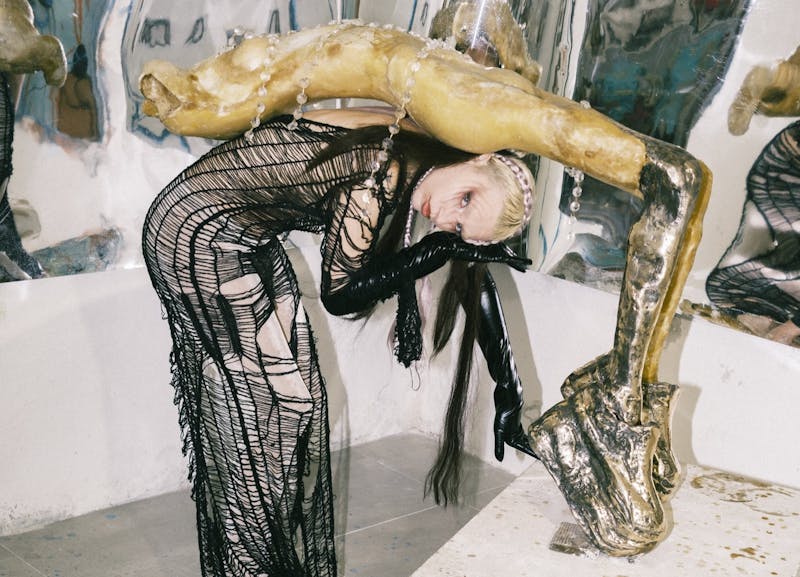
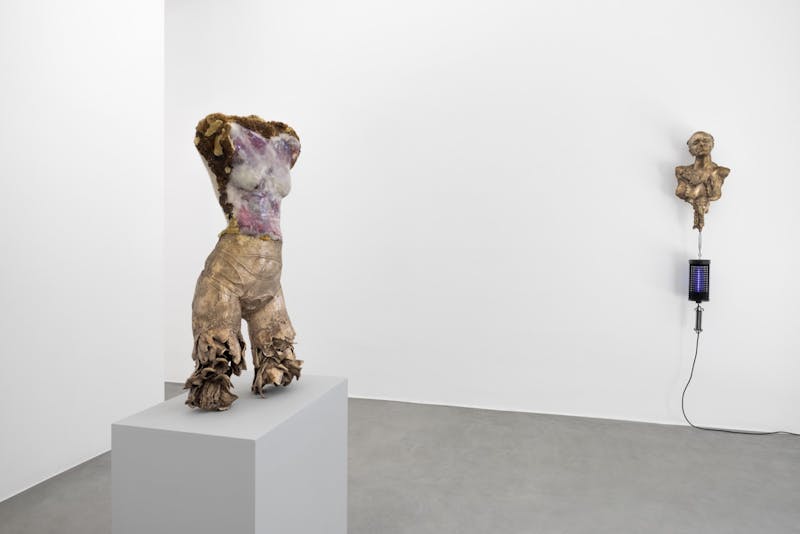
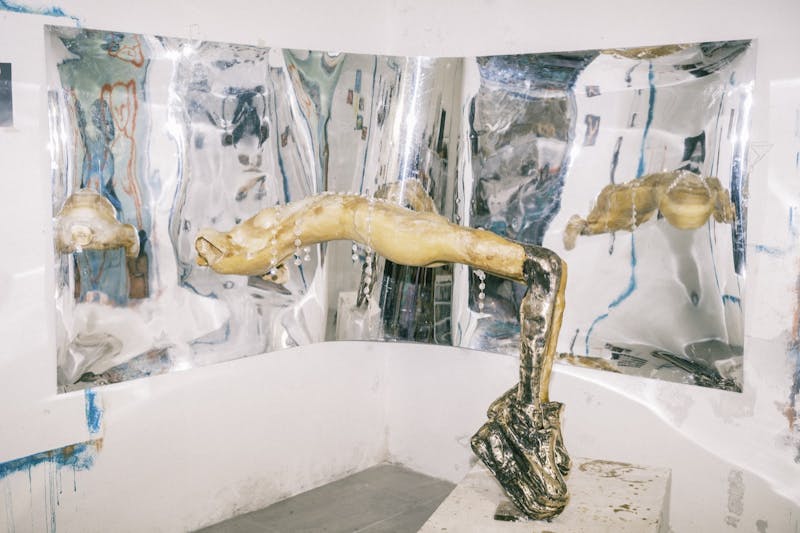
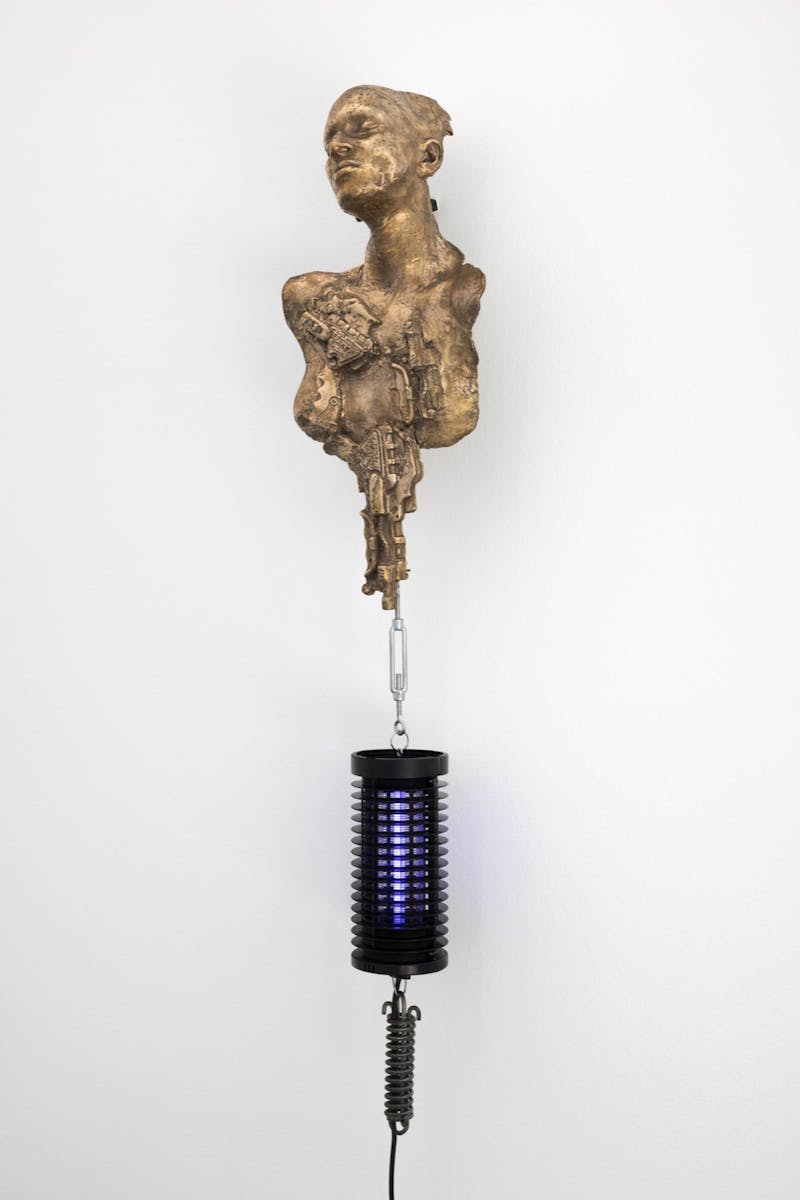
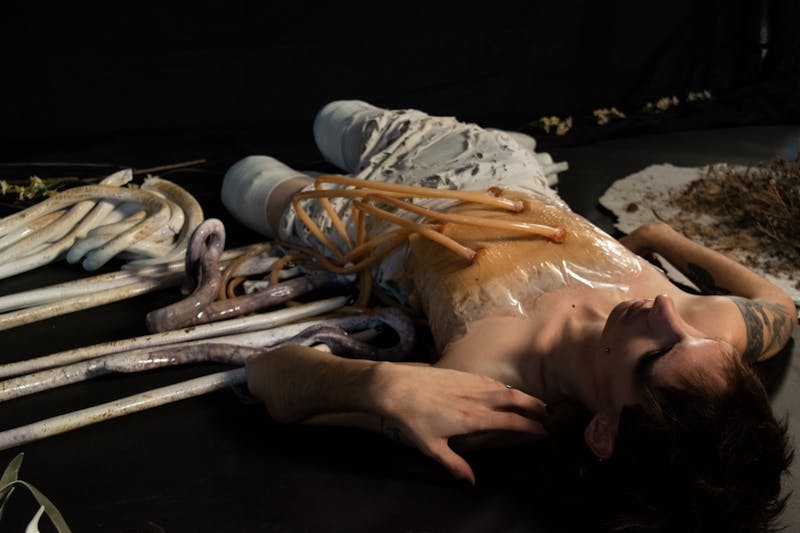
Credits:Artist:Ambra Castagnetti /@ambra_castagnetti_kos
Editor: Maria Abramenko / @mariabramenko
Assistant:Camilla Di Pasquale / @micalliroe Read the original article through the link:Ambra Castagnetti / Transformative bodies
Editor: Maria Abramenko / @mariabramenko
Assistant:Camilla Di Pasquale / @micalliroe Read the original article through the link:Ambra Castagnetti / Transformative bodies